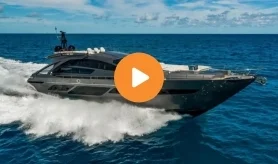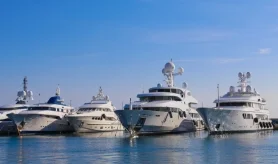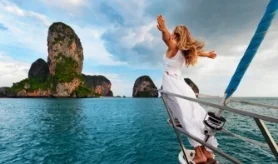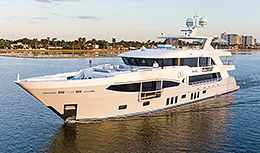- Alaskan Yachts
- Azimut Yachts
- Back Cove Yachts
- Beneteau Yachts
- Benetti Superyachts
- Bertram Yachts
- Boston Whaler
- Broward Yachts
- Buddy Davis Sportfish
- Burger Yachts
- Cabo Yachts
- Catamarans
- Carver Motoryachts
- Center Console
- Chris-Craft Yachts
- Cruisers Yachts
- DeFever Trawlers
- Dufour Sailboats
- Fairline Yachts
- Feadship Yachts
- Ferretti Yachts
- Formula Yachts
- Fountaine Pajot Cats
- Grady-White
- Grand Banks Trawlers
- Hargrave Yachts
- Hatteras Yachts
- Hinckley Picnic Boats
- Horizon Yachts
- Hydra-Sports
- Intrepid Boats
- Jarrett Bay Sportfish
- Jeanneau Yachts
- Kadey-Krogen Trawlers
- Lazzara Yachts
- Lekker Boats
- Luhrs Sportfish
- Marlow Yachts
- Maritimo Yachts
- Marquis Yachts
- McKinna Motoryachts
- Meridian Yachts
- Midnight Express
- MJM Yachts
- Mochi Craft
- Neptunus Motoryachts
- Nordhavn Trawlers
- Nordic Tugs
- Numarine Yachts
- Ocean Alexander Yachts
- Offshore Yachts
- Outer Reef
- Oyster Sailing Yachts
- Pacific Mariner Yachts
- Palmer Johnson Yachts
2022: The Ups, Downs and In-Betweens [In the News]
December 5, 2022 4:40 pm
The Covid buying bubble burst, but show attendance was strong, and new products made a splash
This article was featured on tradeonlytoday.com in November 2022
The roller-coaster ride that began for businesses in 2020 with the Covid-19 pandemic continued throughout 2022, adding a few stomach-flipping bends and turns in the track.
On the one hand, there has been quite a bit of good news since January. Some supply-chain kinks aren’t as knotted as they were a year ago, and boat shows reported good sales and traffic. New boaters continued to embrace the sport, as more than a few companies introduced products to make boating easier and more eco-friendly. Mergers and acquisitions also indicated strength in various segments. On the other hand, acts of God and war created multiple new problems this year, as did a cascade of economic problems, including increased inflation, record-high oil prices, a crashing stock market and recession fears.
Needing to be resilient against whatever might happen next was already on everyone’s minds by the time powerful and deadly Hurricane Ian struck southwest Florida in late September. The storm damaged or destroyed hundreds of millions of dollars’ worth of boats, many of which owners will be looking to repair or replace — just as the industry is seeing the bottom fall out of the Covid buying bubble.
The Covid Bubble Bursts
As early as last spring, indications pointed to a burst in the Covid boat-buying bubble. By August, Matt Gruhn, president of the Marine Retailers Association of the Americas, was hearing dealers say things like: “All the preordered boats have been delivered, and new-boat sales have completely dried up.”
Then, in October, the National Marine Manufacturers Association reported that in the first seven months of the year, new-boat sales dipped below the 2019 pace. The situation is not unique to boating, NMMA president and CEO Frank Hugelmeyer noted, with most industries feeling various economic pressures.
Acts of God and War
Meanwhile, acts of God and war added to existing pressures. In February, Russia invaded Ukraine, sparking widespread international condemnation. The marine industry was affected in multiple ways, with sanctions against Russian oligarchs leading to yachts being seized, and Ukrainian employees at such companies as Axopar in Poland leaving their jobs to head to the front lines. Employees at BRIG, one of the world’s largest RIB builders, had to flee the company’s primary production yard, in a region of Ukraine that Russia targeted.
As the war continued, monster Hurricane Ian took aim at southwest Florida. It made landfall as a Category 4 storm and became the state’s deadliest hurricane since 1935, killing more than 100 people. Early estimates were that damage to boats alone would be in the hundreds of millions of dollars.

And Hurricane Ian forced the cancellation of the International BoatBuilders’ Exhibition and Conference, which had been scheduled for late September in Tampa, Fla., following a virtual conference in 2020 because of the Covid-19 pandemic and significantly lower attendance in 2021 because of the Omicron variant. “We were on track to have an excellent event,” Anne Dunbar, IBEX show director, announced. “The entire IBEX team is very disappointed, but the safety of our community is our priority. This was the right choice.”
On Capitol Hill
There was a return to in-person attendance at the American Boating Congress advocacy event on Capitol Hill in May. Marine-industry representatives talked with lawmakers about everything from sustainability and innovation to electrification and policymaking.
Then, in August, those relationships in Washington, D.C., became all the more important after the National Oceanic and Atmospheric Administration announced a proposed rule that would limit boats as small as 35 feet to 10 knots for months at a time along the East Coast, to try to protect endangered North Atlantic right whales from vessel strikes. Industry opposition to the proposed rule was immediate and fierce, with NMMA calling on every marine brand, employee and boat owner to submit a public comment opposing a proposed rule.

“The industry will be truly decimated if this goes into effect,” Hugelmeyer said. “A 10-knot speed limit for almost all of the coast for most of the year — nobody will keep their boats.” As this issue of Soundings Trade Only went to press, discussions about the proposed rule were continuing.

Industry Programs
Several new and updated programs benefitted the marine industry this year. In August, the American Sportfishing Association announced the inaugural Keep America Fishing Tournament, with dates in early September. The tournament had salt and freshwater categories. First-place winners received a prize package presented by Johnson Outdoors.
Also in August, the American Boat & Yacht Council published the 62nd supplement to its Standards and Technical Information Reports for Small Craft. The update included 20 new and revised standards and technical reports, including guidance for lithium-ion batteries, warnings and safety signs for boats, and manufacturer statements of origin. “ABYC has developed technical tools to assist the industry to prepare for 2024 model year requirements today,” ABYC technical vice president Craig Scholten said.
And in September, MRAA launched a podcast called “The Boat Biz,” with insights and actionable items for dealerships and business owners. The inaugural episode featured MRAA education vice president Liz Walz, who broke down educational programs the association offers.

Strong Shows
Industry employees and executives celebrated the full-speed-ahead return of in-person boat shows, including those that had continued during the pandemic with limited crowds. In February, the rebranded Discover Boating Miami International Boat Show became the first show integrated under the Discover Boating banner. It generated an estimated $955.6 million for Florida’s economy, according to an impact report by Thomas J. Murray and Associates, with 100,000 visitors and total sales for exhibitors of approximately $642 million.
The boom from in-person events continued in July, when ICAST returned to the Orange County Convention Center in Orlando, Fla. That show drew more than 12,000 industry representatives, according to the American Sportfishing Association. “The fishing tackle industry is alive and well and looking strong for the future,” ASA president Glenn Hughes said.
And interest in shows was so strong that Active Interest Media (the parent of Soundings Trade Only) announced the launch of the Connecticut Fall Boat Show. The inaugural show was held in early October at Safe Harbor Bruce & Johnsons Marina in Branford, Conn.

Business Moves
Numerous companies made moves this year in various segments of the industry. In January, Imtra announced that it had sold 100 percent ownership rights of the company to its employees through an employee stock ownership plan. “It is a win-win-win-win, as not only our customers, suppliers and employees will be happy with the changes, but our shareholders are also thrilled with the outcome of the deal. ESOPs are also an effective way to address wealth inequality in our culture,” president and CEO Eric Braitmayer said at the time.
February’s big news was that Fortnine, which sells power sports equipment through an e-commerce platform, acquired the marine outfitter Defender Industries in partnership with private equity firm Novacap. In March, OneWater announced plans to acquire Denison Yachting. At the time, OneWater operated 75 retail locations and 10 distribution centers, while Denison Yachting had 21 U.S. offices and reported 2021 sales of more than $80 million.
Also in March, Brunswick announced the appointment of Jennifer Koenig as the company’s first chief sustainability officer. Candela, the Swedish builder of electric hydrofoil boats, opened a “test drive” center in California, its first in the United States, and Navico announced plans to expand its Ensenada, Mexico, production facility by 35 percent.

In April, Yanmar acquired a majority stake in Netherlands-based battery developer ELEO Technologies, which is known for modular battery packs and thermal management. Yanmar’s announcement said the company was committed to delivering electric powertrain solutions for zero-emission cruising.
There was a milestone in June, when parent company Brunswick Corp. reported that its Freedom Boat Club had hit 50,000 members, just a few months after announcing that the club had plans to open its 350th location. Brunswick CEO David Foulkes predicted a “long runway for growth” with the boat-club model. More news came in June from U.K.-based Williams Jet Tenders, which opened a new research and development space. It has a test tank for tenders as large as 23 feet, along with other new factory equipment.
And August brought word that Sea Tow was receiving more than $1 million in grants to advance its Life Jacket Loaner Program and Sober Skipper Campaign. Additionally, MarineMax announced that it acquired IGY Marinas, which offers a global network of 23 curated marinas in the Americas, the Caribbean, and Europe.
Noteworthy Product Debuts
Of course, the year brought product debuts in all kinds of categories. Sea Ray announced the SLX 260, its first boat from an all-woman design team. Prestige launched the M48, a power cat that is the first boat in its new M-Line range. And Hacker Boat Co. unveiled a new range of mahogany powerboats called the Evolution Collection.
Engine-manufacturers worked hard to top one another. BRP unveiled multiple new products, including Rotax outboards in 115- and 150-hp configurations that the company says are 20 percent more fuel efficient than traditional outboards, with lower emissions. Evoy announced a 300-hp electric outboard that, the company says, is the most powerful ever produced. Mercury Marine also announced new outboards, including a prototype for the Mercury Avator electric outboard. Suzuki revealed the DF250SS, a 250-hp 4-stroke that is the flagship of the company’s Sport Series high-performance outboards. And Ilmor introduced a supercharged 6.2-liter inboard that it says is the world’s most powerful towboat engine, producing 630 hp and 665 pound-feet of torque.
Making the on-board experience more comfortable, Seakeeper unveiled the Seakeeper Ride, which adds controlling a boat’s pitch to the original Seakeeper’s ability to minimize roll. Hinckley’s electric SilentJet also made its debut, enabling silent running over longer ranges.
Battery-manufacturers also made strides. RELiON Battery unveiled its InSight series 12-volt lithium battery, to power components and appliances for longer periods. Mastervolt introduced the MLI Ultra 1250 lithium-ion battery, the most compact in its range and capable of operating up to 3,500 cycles at a depth of discharge up to 80 percent.

Lastly, helm electronics got a few upgrades. Garmin introduced LiveScope Plus sonar, with a new transducer that reportedly delivers 35 percent improved target separation and the ability to identify and separate targets as small as 14 inches at a distance of 100 feet. Raymarine unveiled YachtSense, a remote monitoring system that provides users with control of Raymarine equipment and boat systems from mobile devices through a new app. And Simrad debuted its NSX multifunction displays following a two-year research-and-development effort across the company’s global tech team.




![2022: The Ups, Downs and In-Betweens [In the News]](https://cdn.denisonyachtsales.com/wp-content/uploads/2022/11/In-the-News-Thumbnail-1400-x-900-px-31.jpg)
![2022: The Ups, Downs and In-Betweens [In the News] Share on Facebook](https://cdn.DenisonYachtSales.com/images/share1.svg)
![2022: The Ups, Downs and In-Betweens [In the News] Share via Email](https://cdn.DenisonYachtSales.com/images/share2.svg)
![2022: The Ups, Downs and In-Betweens [In the News] Share on Twitter](https://cdn.DenisonYachtSales.com/images/share3.svg)


